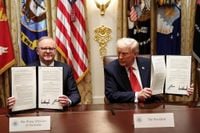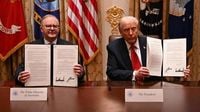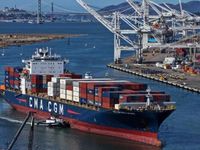The global race for control over rare earth elements and critical minerals intensified this week as the United States and Australia unveiled a landmark agreement designed to challenge China’s near-monopoly over these essential resources. Signed in Washington by President Donald Trump and Prime Minister Anthony Albanese, the deal represents a strategic pivot for both nations, aiming to secure supply chains for materials vital to electric vehicles, renewable energy, defense systems, and advanced electronics.
According to MT Newswires, US stock futures dipped 0.1% in premarket trading on October 21, 2025, as investors digested the implications of the new minerals pact alongside a flurry of major corporate earnings reports. The agreement, which pledges over $3 billion in joint investment, is widely seen as a direct response to Chinese export restrictions and escalating geopolitical tensions between Washington and Beijing.
The urgency of the move is underscored by China’s current dominance in the rare earths sector. As Darryl Cuzzubbo, CEO of Arafura Resources, put it to The Sydney Morning Herald, “China controls 90% of rare earths production and has historically manipulated prices as a geopolitical tool.” Cuzzubbo warned that such leverage enables Beijing to wield rare earths as a weapon against manufacturing nations, creating instability in global markets.
To counteract this, the US-Australia agreement will channel at least $1 billion USD (about $1.5 billion AUD) from each country into critical projects over the next six months, supporting an $8.5 billion USD ($13 billion AUD) pipeline of initiatives in both nations, The Nightly reported. Two Australian projects have been singled out for immediate support: the Alcoa-Sojitz Gallium Recovery Project in Western Australia and the Arafura Nolans project in the Northern Territory.
The Alcoa project, expected to secure up to 10% of the global gallium supply, will receive up to $200 million USD ($307 million AUD) in concessional equity finance from the Australian government, with the US Department of War providing additional investment for an advanced refinery. Gallium is a crucial component in semiconductors, circuits, and solar cells—technologies that underpin both modern industry and national security.
Meanwhile, the Arafura Nolans project will benefit from a $100 million USD ($153 million AUD) equity investment and is projected to produce 5% of the world’s rare earths, essential for smartphones, weapons systems, and clean energy technologies. The scale and scope of these investments reflect a broader trend: Western governments are scrambling to diversify their supply chains away from China, whose recent export curbs have sent shockwaves through global markets.
To coordinate these efforts, a US-Australia Critical Minerals Supply Security Response Group will be established, led by Australia’s Minister for Resources Madeleine King and US Secretary of Energy Charles Wright. Their mandate is to identify priority minerals, assess supply vulnerabilities, and accelerate the delivery of processed materials—a move that could reshape the international trade landscape for years to come.
Markets, however, remain cautious. While the minerals deal was welcomed as a bold step, it comes amid a complicated backdrop of US-China relations. President Trump’s administration has announced plans to impose 100% tariffs on Chinese imports starting November 1, 2025, a move that raises the stakes ahead of a highly anticipated meeting with Chinese President Xi Jinping at the Asia-Pacific Economic Cooperation (APEC) summit in Gyeongju, South Korea. Trump’s itinerary also includes stops in Malaysia and Japan, underscoring a coordinated diplomatic push to shore up alliances across the Asia-Pacific region.
“I don’t want them to play the rare earth game with us,” Trump told reporters, according to Yahoo Finance. He acknowledged that China may retaliate with threats over rare earths, but insisted, “I could threaten them with many other things.” The president’s top economic adviser, Kevin Hassett, described the minerals agreement as a “de-risking” measure, saying, “Australia is really, really going to be helpful in the effort to take the global economy and make it less risky, less exposed to the kind of rare earth extortion that we’re seeing from the Chinese.”
Despite optimistic rhetoric, analysts caution that the US and its allies face a steep uphill battle. As Ellen Ehrnrooth and Ed Mills of Raymond James noted in a recent analysis, “Even with the ongoing flurry of efforts to reshore/onshore/friendshore rare earths production, the U.S. is still many years away from self-sufficiency.” China’s grip on both mining and processing capacity remains formidable, and any shift in global supply chains will require sustained investment and international cooperation.
The political dimensions of the deal have not gone unnoticed. China’s state-run Global Times dismissed the agreement as a “pledge of loyalty to the US,” likening it to Australia’s alleged “warplane intrusion” in the South China Sea. The newspaper quoted an academic who argued that the $4.6 billion investment represents alignment with Washington’s geopolitical agenda rather than an independent Australian policy. This comparison underscores the broader contest for influence in the Indo-Pacific, where economic, military, and diplomatic maneuvers are increasingly intertwined.
Back in financial markets, the minerals deal has contributed to a mood of cautious optimism, even as uncertainty lingers. Treasury yields have held steady at 3.47% for two-year bonds and 3.99% for ten-year bonds, while oil prices edged up to $58.05 per barrel. Gold and bitcoin, by contrast, slipped slightly, reflecting investor wariness as they weigh mixed corporate earnings, the risk of a US government shutdown, and the broader implications of shifting trade alliances.
As Trump prepares for his diplomatic tour across Asia, the world will be watching closely to see whether the US-Australia minerals agreement marks the beginning of a new era of resource security—or simply the latest move in a high-stakes chess match with Beijing. With both sides signaling readiness to escalate, and with critical minerals now at the heart of global competition, the next chapter in this unfolding drama promises to be anything but dull.
For policymakers and businesses alike, the message is clear: in a world defined by economic nationalism and technological rivalry, securing access to rare earths and critical minerals is no longer just about business—it’s about national security, strategic autonomy, and the future shape of the global order.


